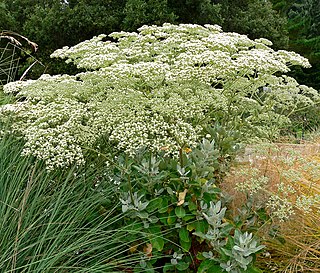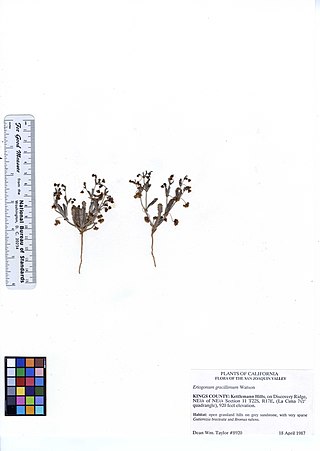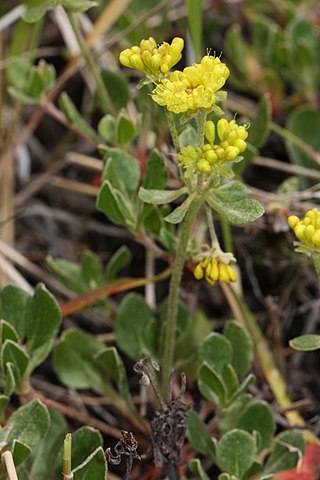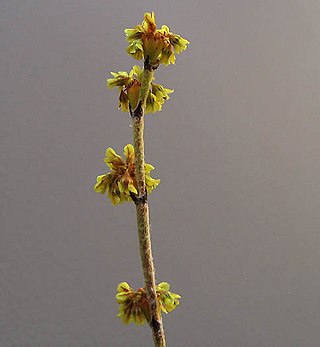
Eriogonum nudum is a perennial shrub of the wild buckwheat genus which is known by the common name naked buckwheat or nude buckwheat.

Eriogonum fasciculatum is a species of wild buckwheat known by the common names California buckwheat and flat-topped buckwheat. Characterized by small, white and pink flower clusters that give off a cottony effect, this species grows variably from a patchy mat to a wide shrub, with the flowers turning a rusty color after blooming. This plant is of great benefit across its various habitats, providing an important food resource for a diversity of insect and mammal species. It also provides numerous ecosystem services for humans, including erosion control, post-fire mitigation, increases in crop yields when planted in hedgerows, and high habitat restoration value.
Eriogonum dasyanthemum is a species of wild buckwheat known by the common name chaparral buckwheat. This plant is endemic to California where it is limited to the Northern Coast Ranges, but it is quite common in its native range.

Eriogonum deflexum is a species of wild buckwheat known by the common names flatcrown buckwheat, flat-top buckwheat, and skeletonweed. This plant is native to the southwestern United States and northwestern Mexico, where it is common and grows in a variety of habitats, especially desert scrub. It is somewhat weedy where it is most abundant. This is an annual which varies in size from small patches on the ground to tangled bushes approaching two meters in height; it may be dense or thin and spindly. This is a brown or greenish weedy-looking herb with a many-branched stem. The leaves are located at the base of the plant and are rounded and woolly and one to four centimeters long. Small clusters of flowers appear at intervals along the branches with each flower only one to three millimeters wide and white or pinkish in color.

Eriogonum giganteum, with the common name St. Catherine's lace, is a species of wild buckwheat in Southern California.

Eriogonum gracillimum is a species of wild buckwheat known by the common name rose and white buckwheat. It is endemic to California but is common and widespread in many areas there. This is a spindly annual herb reaching anywhere from 5 to 50 centimeters in height. Most of the leaves are basal with a few scattered on the thin branched stem and are generally one to four centimeters long and somewhat woolly, with edges rolled under. Along the thread-thin branches of the stem appear small clusters of flowers which hang on short stalks in bell-shaped involucres. The two-millimeter-wide flowers are bright rose and white in color.

Eriogonum maculatum is a species of wild buckwheat known by the common name spotted buckwheat. It is native to western North America from Washington to Baja California to Utah, where it can be found in a number of habitats, often in abundance.

Eriogonum nidularium is a species of wild buckwheat known by the common name birdnest buckwheat. It is native to the sandy flats and desert dry washes of the Mojave Desert and Great Basin in the western United States, where it is common and abundant. This is a distinctive annual herb producing a thin, multibranched stem which curves in on itself to form a rounded, tangled mass.

Eriogonum umbellatum is a species of wild buckwheat known by the common name sulphurflower buckwheat, or simply sulphur flower. It is native to western North America from California to Colorado to central Canada, where it is abundant and found in many habitats, including the sagebrush steppe and alpine areas. It is an extremely variable plant and hard to identify because individuals can look very different from one another. Also, there are many varieties. It may be a perennial herb blooming by summer with stems 10 centimeters tall and two to six clusters of flowers, with a whorl of leaves below the stems, or a sprawling shrub approaching two meters high and wide. The leaves are usually woolly and low on the plant, and the flowers come in many colors from white to bright yellow to purple.

Eriogonum wrightii is a species of wild buckwheat known by the common names bastardsage and Wright's buckwheat. It is native to the Southwestern United States, California, and northwest Mexico, where it grows in many plant communities, such as chaparral, in rocky habitats from mountains to deserts.

Eriogonum ampullaceum is a species of wild buckwheat known by the common name Mono buckwheat.

Eriogonum brachyanthum is a species of wild buckwheat that is commonly known as shortflower buckwheat. It is native to eastern California and western Nevada, particularly the Mojave Desert region, where it is common to abundant, and even sometimes weedy. It is also known from southern Oregon. The plant grows in sandy habitats such as desert flats and sagebrush. It also grows in pinyon-juniper and montane conifer woodlands. It is an annual herb that grows 30 to 40 centimeters tall. Leaves are located at the base of the stem, woolly, and oval or rounded in shape. The top of the stem is occupied by a branching inflorescence bearing many widely spaced clusters of flowers. Each individual flower is about a millimeter wide and light yellow in color. Flowers bloom from April to November.

Eriogonum cithariforme is a species of wild buckwheat known by the common name cithara buckwheat.

Eriogonum gracile is a species of wild buckwheat known by the common name slender woolly buckwheat.
Eriogonum hookeri is a species of wild buckwheat known by the common name Hooker's buckwheat. It is native to the Intermountain West of the United States, where it grows in plateau and desert habitat.
Eriogonum molestum is a species of wild buckwheat known by the common name pineland buckwheat. It is endemic to southern California, where it grows in the Transverse Ranges of Ventura County to the Peninsular Ranges of San Diego County.

Eriogonum panamintense is a species of wild buckwheat known by the common name Panamint Mountain buckwheat. It is native to several of the desert mountain ranges of eastern California and western Nevada, including the Panamint Range. It grows in various types of mountain ridge habitat, such as sagebrush and coniferous woodland.
Eriogonum pendulum is a rare species of wild buckwheat known by the common name Waldo buckwheat. It is endemic to the Klamath Mountains of Josephine County, Oregon, and Del Norte County, California, where it is a member of the serpentine soils flora.

Eriogonum siskiyouense is a rare species of wild buckwheat known by the common name Siskiyou buckwheat.

Eriogonum spergulinum is a species of wild buckwheat known by the common name spurry buckwheat.
















